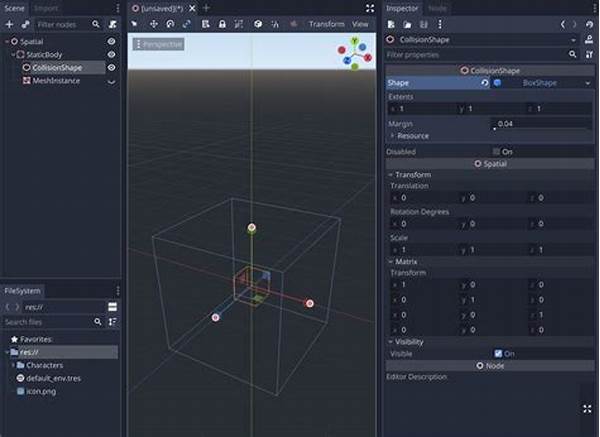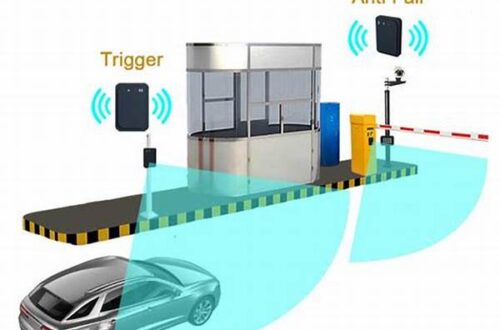Hey there, fellow virtual adventurers and game enthusiasts! Ever stumbled upon the nerdy yet fascinating world of bounding boxes and collision meshes? Well, grab a coffee or your favorite gamer snack because today we’re diving into this essential piece of game development tech. Whether you’re a seasoned developer or just a curious onlooker, understanding these concepts can really enhance how you view your favorite digital worlds.
Read Now : “game Building With Visual Editors”
What are Bounding Boxes and Collision Meshes?
Bounding boxes and collision meshes are tools used by game developers to determine how objects in virtual environments interact with each other. In the simplest terms, a bounding box is like an invisible 3D box wrapped around a nifty 3D character or object. It’s the superhero behind the scenes, ensuring your character doesn’t walk through walls or fall through the floor. On the other hand, collision meshes take things to a more intricate level. They’re like complex webs of points and lines that precisely match the shape of the object, providing a higher level of detail for collision detection. So, while bounding boxes give you the quick and dirty version, collision meshes bring in all the juicy details. Together, they ensure a smooth, believable gaming experience.
Why do these matter, you ask? Imagine playing your favorite racing game and your car passes right through a tree without a scratch. Awkward, right? That’s where bounding boxes and collision meshes come in, keeping things realistic and fun. Plus, understanding the balance between them helps devs manage game performance since both have varying impacts on processing power. So next time you play a game and your avatar perfectly dodges an obstacle, give a little cheer for these unseen heroes!
Why Use Bounding Boxes and Collision Meshes?
1. Efficient Processing: Bounding boxes are awesome for quick calculations, saving your device’s processing power for more important tasks. Collision meshes, while detailed, need more computing juice.
2. Realistic Interactions: Ever notice how your avatar bumps into objects naturally? That’s the magic of collision meshes making toy-like interactions a thing of the past.
3. Performance Balance: Games juggle between bounding boxes and collision meshes to balance realism and speed. It’s like having your cake and eating it too!
4. Complex Environments: For complicated shapes, like dragons or sprawling castles, collision meshes shine. They provide detailed collision detection that bounding boxes can’t handle.
5. Gaming Experience: Without accurate collision detection, you’d be walking through walls like a ghost! These techniques make sure gameplay stays immersive and exciting.
The Role of Bounding Boxes in Gaming
Let’s break down why bounding boxes are the unsung heroes of gaming. Picture this: you’re in an open-world game, surrounded by NPCs, trees, and buildings. Every item has a bounding box, like a personalized space, to ensure interactions don’t get chaotic. Bounding boxes are especially great for simple objects or when precision isn’t dire – their calculations are quick, allowing the game to maintain a seamless flow without any lag. They map out spaces quickly, making sure your in-game actions feel smooth like honey.
Bounding boxes are the backbone of most simulation interactions, helping the game engine decide whether objects should collide or not. Without them, you’d have games with clunky characters and unpleasant glitches. So, whenever your character navigates through a crowded marketplace without merging into other characters like some weird sci-fi movie, just know a bounding box has got your back.
Unveiling Collision Meshes Secrets
Understanding collision meshes can seem daunting, but it’s entirely worth the peek under the hood. They offer precision that bounding boxes simply can’t match. For games like shooters or any with physics-based gameplay, every bullet, curve, and bump is accounted for in intricate detail using collision meshes. It’s how games calculate how a skateboarding character should react when hitting a pebble or achieving that perfect trick.
Read Now : Broad-phase Spatial Partitioning Techniques
Collision meshes allow for more realistic reactions because they follow the object’s unique shape. You might wonder why not use them all the time? Well, they’re resource-intensive. The game engine needs to work harder to keep up with the complexity. Here’s a pro-tip for aspiring game devs: figuring out the right balance between bounding boxes for lesser detailed interactions and collision meshes for intricate ones is key to a successful game engine performance.
Bounding Boxes and Collision Meshes: A Playful Duo
Combining the practicality of bounding boxes with the precision of collision meshes creates the perfect duo in gaming. It’s like peanut butter meets jelly – different yet complementary. Bounding boxes take care of broader interactions, streamlining what the game engine has to process. So when your character jumps, lands, or takes a sharp corner, the bounding box keeps operations smooth.
On the other side, collision meshes inject realistic physics where it matters most. When complex terrains or detailed environments arise, collision meshes take center stage. It’s the synergy between the two that ensures fast-paced, spectacular, and realistic-looking interactions, giving players the immersive experiences they crave.
When to Use Bounding Boxes and Collision Meshes
Understanding when to use bounding boxes and collision meshes involves a strategic balance essential in game design. Often it’s guided by the game’s complexity and the interactions required. If you’re designing a platformer, bounding boxes might handle most of the grunt work, letting characters jump, land, and navigate with ease. But if you’re delving into virtual reality or ultra-detailed RPGs, collision meshes fill in those nuanced details, like perfectly depicting a sword’s path or capturing the ripple of a water effect.
Mastering their use means smoother, faster games with fewer glitches, adding to a player’s engagement without maxing out their console’s or PC’s performance limits. It’s all about maintaining fluid, visual harmony while crafting breathtaking worlds for players to explore.
Conclusion: Cheer for Bounding Boxes and Collision Meshes
In summary, while bounding boxes and collision meshes might not star in the game credits, they certainly deserve a standing ovation. By breaking down boundaries between reality and virtual play, they help game developers craft stronger narratives and more engaging stories. Whether a shadowy dungeon or a sunlit meadow, these tools provide structure to every game world in the market.
Remember, the next time you skillfully dodge an obstacle or manage to pull off an unbelievably cool trick in your favorite game, there’s a whole lot of magic happening behind the scenes. And for all aspiring game devs, understanding these nifty tools can open up new doors to creativity, making the unreal, feel oh-so-real. Cheers to bounding boxes and collision meshes, the unsung heroes of our gaming adventures!





